How to Freeze Spinach
Freezing spinach is a simple and convenient way to preserve this nutritious green vegetable. It not only minimizes produce waste but also ensures that you always have spinach on hand whenever you need it. Whether you want to use it in smoothies, soups, stir-fries, or pasta dishes, frozen spinach is a versatile ingredient that can elevate your meals without compromising on taste or nutrition.
How to Freeze Spinach – Key Takeaways:
- Freezing spinach is an easy way to minimize produce waste and have spinach readily available.
- You can freeze whole spinach leaves without blanching them, making the process even simpler.
- Consider pureeing spinach before freezing to have it ready for various recipes.
- Thawed frozen spinach is best used in cooked or blended dishes, such as smoothies, soups, and dips.
- By properly storing and organizing your frozen spinach, you can ensure its freshness and easy access.
Why Freeze Spinach?
Freezing spinach not only helps to prevent food waste but also ensures that you always have spinach available for your culinary creations. Whether you have an abundance of fresh spinach from your garden or purchased a large bag from the store, freezing is a simple and effective method to preserve this nutritious leafy green.
By freezing spinach, you can extend its shelf life and maintain its flavor, texture, and nutritional value. Spinach is packed with vitamins A, C, and K, as well as iron, calcium, and antioxidants. Incorporating frozen spinach into your meals allows you to reap these health benefits year-round.
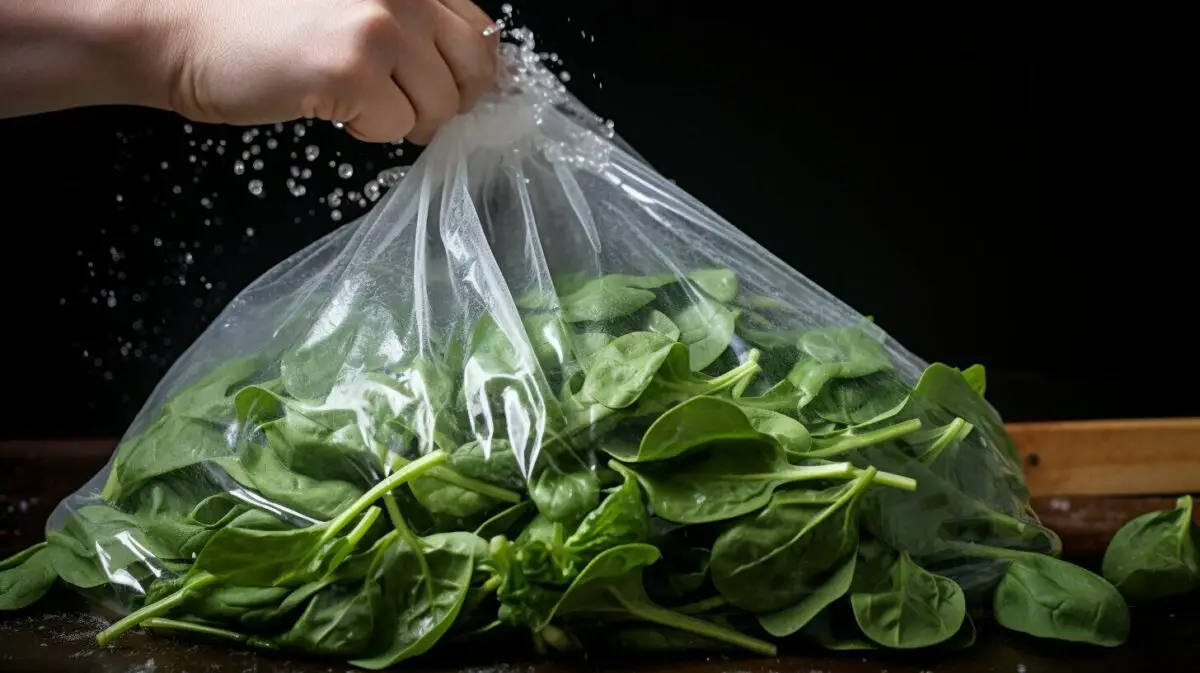
When freezing spinach, it’s important to choose fresh leaves, remove any icky or wilted leaves, and properly prepare them for freezing. This can be done by either freezing whole spinach leaves or pureeing them before freezing. The freezing method you choose will depend on your personal preference and how you plan to use the spinach in the future.
Freezing spinach is a convenient and practical way to ensure that you always have this versatile ingredient on hand. Whether you’re making a quick weeknight pasta dish or adding a nutritious boost to your morning smoothie, frozen spinach is a valuable addition to your freezer.
Selecting Fresh Spinach
Before freezing spinach, it’s important to select fresh and high-quality leaves to ensure the best results. Look for spinach with vibrant green color and crisp leaves. Avoid any wilted, yellowed, or slimy leaves, as they may affect the taste and texture of the frozen spinach.
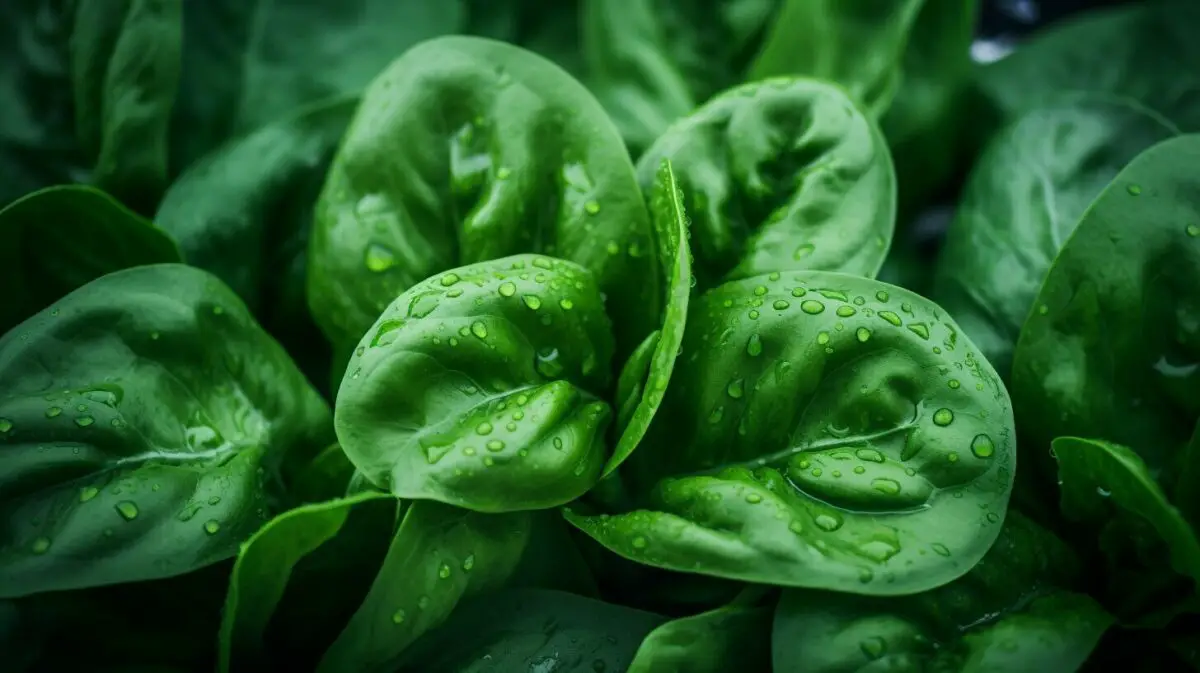
If possible, choose organic spinach to minimize exposure to pesticides. Organic spinach is typically grown without synthetic chemicals, making it a healthier choice. Alternatively, you can grow your own spinach at home using organic gardening methods for the freshest and most nutritious leaves.
When preparing the spinach for freezing, gently wash the leaves in cold water to remove any dirt or debris. Pat them dry with a clean kitchen towel or paper towels to remove excess moisture. This step is important to prevent ice crystals from forming on the leaves during freezing, which can affect their texture.
Once the spinach leaves are cleaned and dried, you can proceed with the freezing methods that best suit your needs and preferences. Whether you choose to freeze whole leaves or puree the spinach, remember to label the containers with the freezing date for easy organization and to ensure you use the spinach within the recommended storage times.
Whole Leaf Freezing Method
Freezing whole spinach leaves is a quick and easy method that allows you to preserve the natural texture and flavor of the greens. This method is perfect if you prefer to have intact spinach leaves for recipes like salads or sautés. Here’s how you can freeze spinach leaves without blanching:
- Start by selecting fresh and vibrant spinach leaves. Look for leaves that are crisp and free from any browning or wilting.
- Remove any icky or damaged leaves from the bunch.
- Give the spinach leaves a good rinse under cold water to remove any dirt or debris.
- Gently pat the leaves dry with a paper towel or use a salad spinner to remove excess moisture.
- Place the spinach leaves in a Ziploc freezer bag.
- Using a straw, suck out as much air as possible from the bag before sealing it. This will help prevent freezer burn.
- Label the bag with the date of freezing.
- Store the bag of spinach in the freezer for up to six months.
When you’re ready to use the frozen spinach, simply take out the desired amount and thaw it in the refrigerator overnight. Thawed frozen spinach will be wilted and watery, so it’s best to use it in cooked or blended recipes.
Whole Leaf Freezing Method
If you plan to use frozen spinach for soups, stews, smoothies, or sauces, it’s recommended to puree the spinach before freezing. This method allows for easier portioning and faster thawing. Here’s how you can puree and freeze spinach:
- Follow the same steps for selecting and cleaning the fresh spinach leaves.
- Blanch the spinach leaves in boiling water for about 30 seconds.
- Quickly transfer the blanched spinach leaves to a bowl of ice water to stop the cooking process.
- Drain the spinach leaves and squeeze out any excess water.
- Transfer the blanched spinach leaves to a blender or food processor and puree until smooth.
- Portion the pureed spinach into freezer bags, ice cube trays, or baby food containers.
- Label each container with the date of freezing.
- Place the containers in the freezer and store for up to six months.
When you’re ready to use the pureed spinach, simply take out the desired amount and thaw it in the refrigerator or by using the defrost setting on your microwave. The pureed spinach can be added directly to recipes without the need for further cooking.
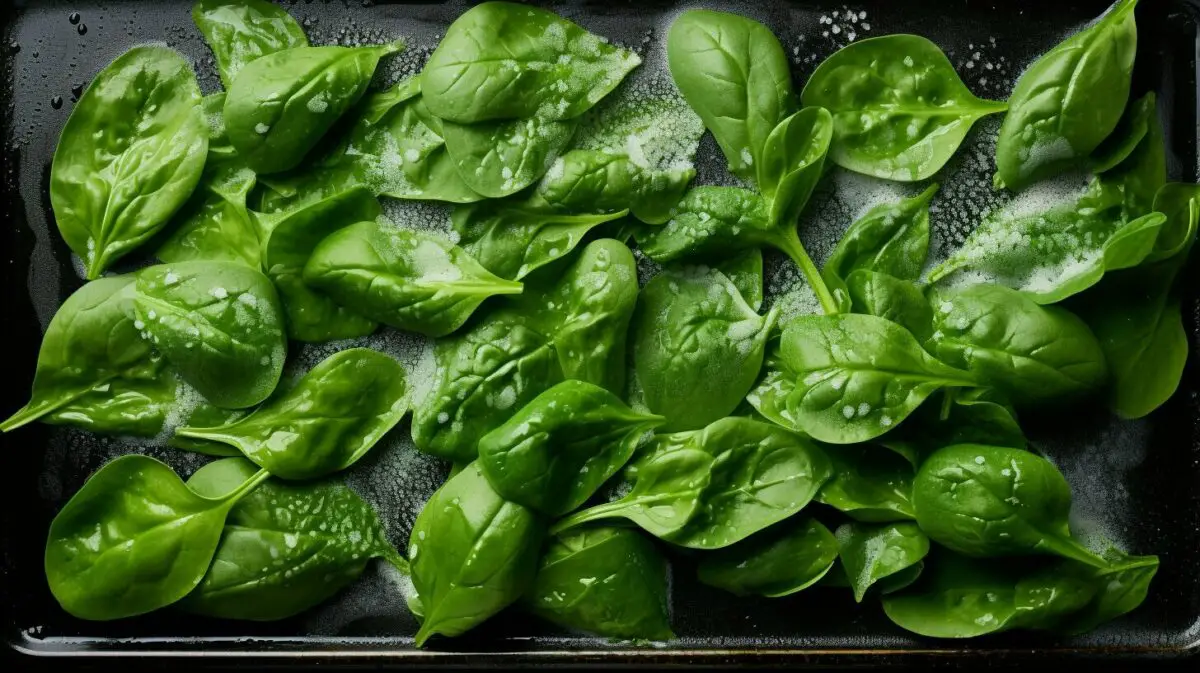
| Method | Texture | Recommended Use |
|---|---|---|
| Whole Leaf Freezing | Intact leaves | Salads, sautés |
| Puree Freezing | Smooth puree | Soups, smoothies, sauces |
Puree Freezing Method
Pureeing spinach and freezing it is a great option if you prefer to have a versatile spinach puree ready to use in your cooking. Whether you want to add a nutritional boost to your morning smoothie or incorporate spinach into pasta sauces or soups, having a stash of frozen spinach puree can be incredibly convenient.
To freeze spinach puree, start by washing the spinach leaves thoroughly and removing any tough stems or discolored leaves. Then, blanch the spinach by boiling it for a brief moment and quickly transferring it to an ice bath to stop the cooking process. Blanching helps to retain the vibrant green color and nutrients in the spinach. Once the spinach has cooled, drain and squeeze out any excess water.
Next, transfer the blanched spinach to a blender or food processor and blend until smooth. If the mixture is too thick, you can add a small amount of water or vegetable broth to achieve your desired consistency. Once blended, pour the spinach puree into freezer-safe containers such as ice cube trays, baby food containers, or Ziploc freezer bags.
Remember to label your containers with the date of freezing. Frozen spinach puree can be stored in the freezer for up to six months. When you’re ready to use the puree, simply thaw it in the refrigerator overnight or defrost it in the microwave using the defrost setting. Thawed spinach puree may appear slightly watery, but this won’t affect the taste or texture when used in cooked dishes. Enjoy the convenience of having spinach puree on hand to add a nutritious and vibrant touch to your favorite recipes!
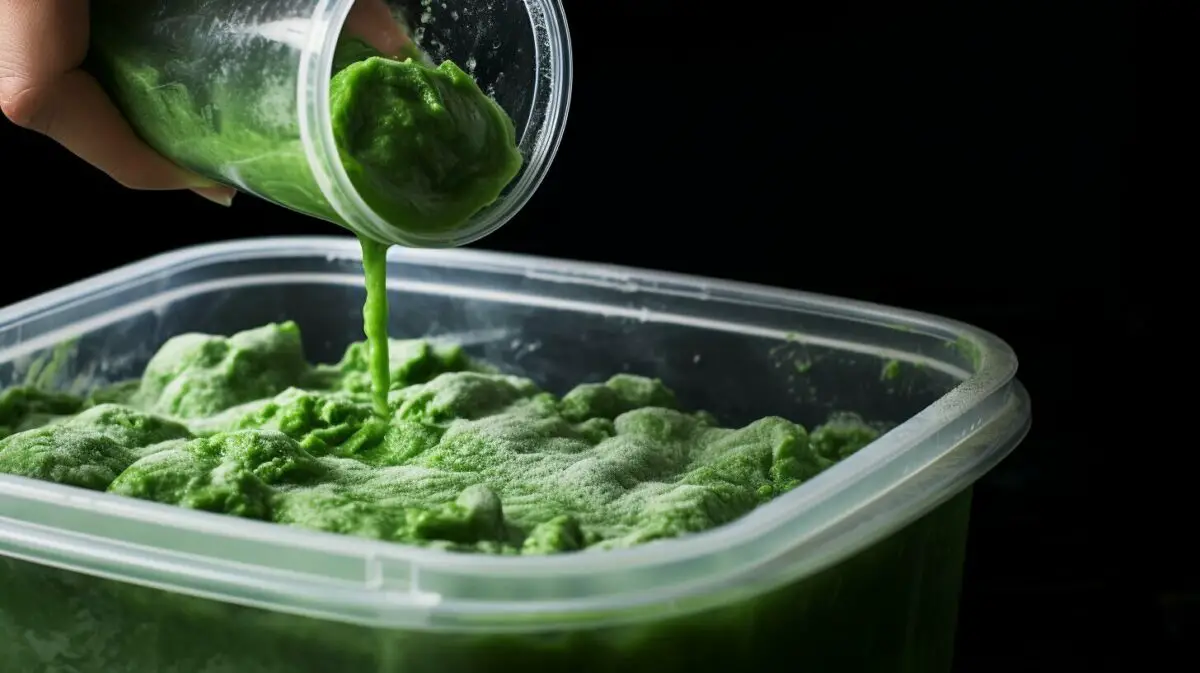
| Benefits of Pureeing and Freezing Spinach |
|---|
| Provides a convenient and ready-to-use spinach puree for cooking |
| Retains the vibrant green color and nutritional value of spinach |
| Allows for portion control by freezing in smaller containers or ice cube trays |
| Extends the storage life of spinach up to six months |
| Offers versatility in incorporating spinach into various recipes |
Freezing Equipment and Containers
Choosing the right freezer bags or containers is crucial to maintain the quality and freshness of your frozen spinach. The right packaging will help prevent freezer burn and keep your spinach tasting its best. There are a few options to consider when selecting the perfect freezing equipment for your needs.
Freezer Bags:
Freezer bags, such as Ziploc bags, are a popular choice for freezing spinach. They are designed to be durable and resistant to moisture, making them ideal for long-term storage in the freezer. When using freezer bags, make sure to squeeze out as much air as possible before sealing the bag. This will help prevent ice crystals from forming and keep your spinach fresh.
Freezer Containers:
If you prefer a more sustainable option, freezer containers are a great choice. Look for containers that are specifically designed for freezer use, as they are made from thicker and more durable materials. These containers are reusable and can help reduce waste. Make sure to leave some headspace in the container to allow for expansion as the spinach freezes.
Ice Cube Trays and Baby Food Containers:
For smaller servings or recipes that require smaller portions of spinach, consider using ice cube trays or baby food containers. These are convenient for portioning out the spinach and can be easily stored in freezer bags or containers once frozen. You can thaw the desired amount of spinach cubes or puree as needed for your recipes.
Remember to label your freezer bags or containers with the date to keep track of how long the spinach has been frozen. Properly labeled packaging will help you use the oldest spinach first and ensure that you always have a fresh supply of frozen spinach on hand.
Table: Freezing Equipment and Containers
| Freezing Equipment | Features |
|---|---|
| Freezer Bags | Durable, moisture-resistant, squeeze out excess air |
| Freezer Containers | Thicker, more durable, reusable |
| Ice Cube Trays and Baby Food Containers | Convenient for smaller portions, easily stored |
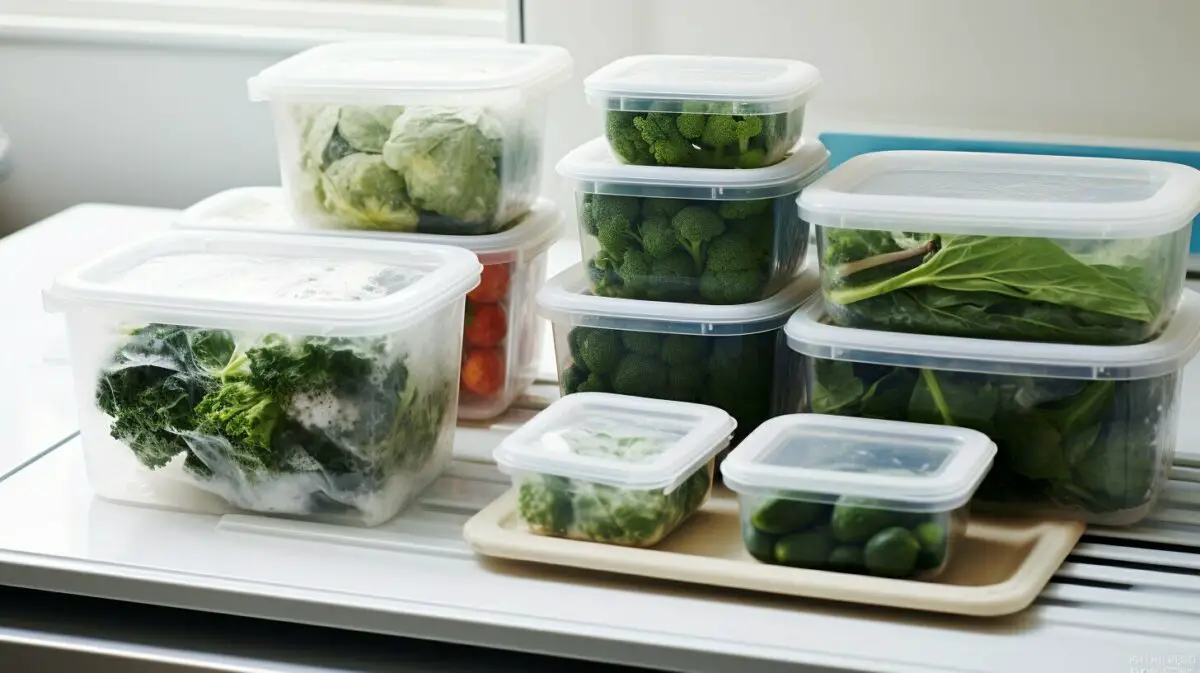
Choosing the right freezer bags or containers is essential for freezing spinach effectively. Whether you opt for freezer bags, containers, or smaller options like ice cube trays, proper packaging will help maintain the quality of your frozen spinach. Don’t forget to label your packages and keep track of storage times to ensure the freshest spinach for your meals and recipes.
Storage Times and Thawing Spinach
Understanding the proper storage times and thawing methods for frozen spinach ensures that it remains safe and flavorful. When properly stored, frozen spinach can maintain its quality for up to 10 months. However, for the best taste and texture, it is recommended to use frozen spinach within 6 months of freezing.
Thawing frozen spinach is a simple process that can be done in the refrigerator, microwave, or using the cold water method. The refrigerator method is the safest and most recommended, as it allows for slow and even thawing without compromising the spinach’s quality.
To thaw frozen spinach in the refrigerator, simply transfer the desired amount of frozen spinach from the freezer to a plate or container and place it in the refrigerator. Allow the spinach to thaw overnight or for approximately 8 hours. Once thawed, make sure to use the spinach within 2 days.
| Thawing Method | Time Needed | Recommended Use |
|---|---|---|
| Refrigerator | 8 hours to overnight | Best for cooked recipes or blended dishes |
| Microwave | 2-3 minutes on defrost setting | Quick thawing for last-minute recipes |
| Cold Water | 30 minutes to 1 hour | Convenient method for faster thawing |
Freezing Tip:
“Before freezing spinach, it’s important to squeeze out as much air as possible from the freezer bags to prevent freezer burn. This can be achieved by using a straw to suck out the excess air or by pressing the bags firmly with your hands to remove any air pockets.”
Once thawed, frozen spinach will lose some of its crispness and become wilted and watery. Therefore, it is best to use thawed spinach in cooked or blended recipes rather than raw salads or sandwiches. Frozen spinach works exceptionally well in smoothies, soups, stir-fries, dips, quiches, and pasta dishes, adding a nutritious boost of vitamins and minerals.
By understanding proper storage times and thawing methods, you can make the most of your frozen spinach, reducing waste and ensuring you always have this versatile and nutritious ingredient readily available in your kitchen.
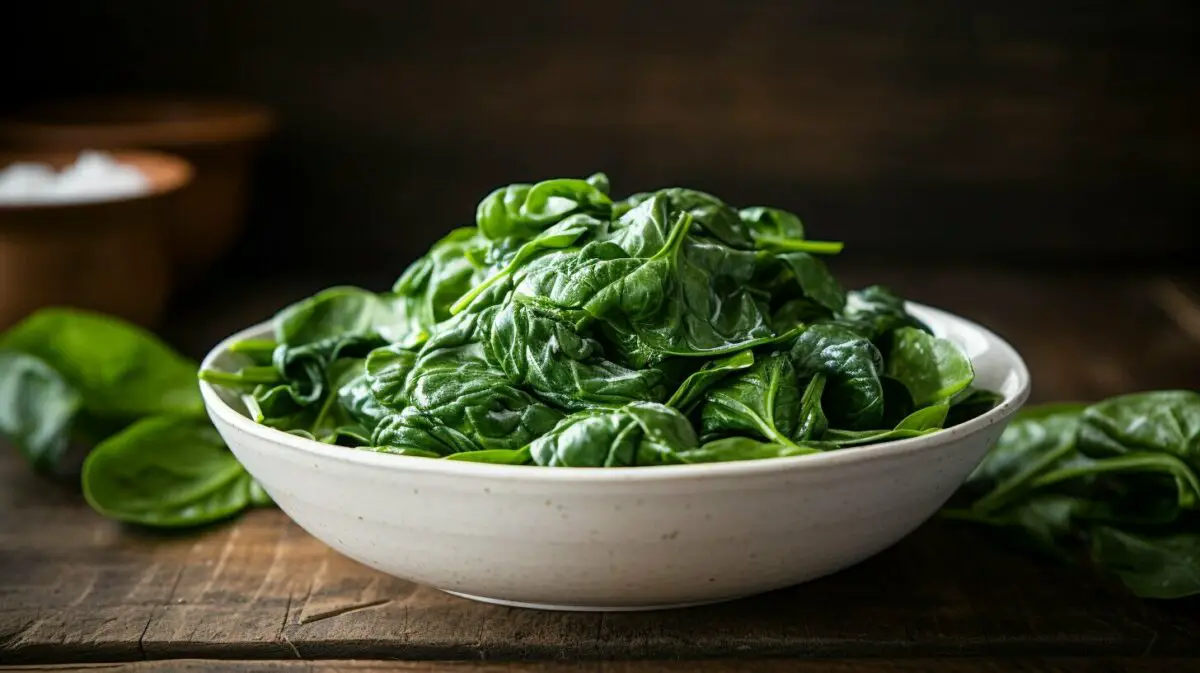
Don’t let frozen spinach limit your culinary creativity – discover how to incorporate it into a wide range of tasty dishes. Freezing spinach is an easy way to minimize produce waste and have spinach on hand whenever you need it. Whether you have whole spinach leaves or pureed spinach, there are countless possibilities for upgrading your recipes with this nutritious green vegetable.
Thawed frozen spinach will be wilted and watery, so it’s best to use it in cooked or blended recipes. The texture may not be suitable for eating the spinach raw in salads or sandwiches. However, frozen spinach works wonders in smoothies, soups, stir-fries, dips, quiches, and pasta dishes.
Here are some delicious ideas for cooking with frozen spinach:
- Spinach Smoothie: Blend frozen spinach with your favorite fruits, yogurt, and a splash of juice or milk for a nutritious and refreshing smoothie.
- Spinach Soup: Add frozen spinach to your favorite soup recipes for an extra boost of vitamins and minerals. It pairs well with flavors like tomato, potato, or lentils.
- Spinach Stir-fry: Sauté frozen spinach with garlic, ginger, and your choice of protein for a quick and healthy stir-fry. Serve it over rice or noodles for a satisfying meal.
- Spinach Sauce: Use pureed frozen spinach as a base for flavorful pasta sauces or pizza toppings. It adds a vibrant green color and a nutritious twist to your favorite comfort foods.
With frozen spinach, you can easily elevate the nutritional content of your meals without compromising on flavor or convenience. Take advantage of this versatile ingredient and let your culinary imagination run wild!

| Recipe | Ingredients | Instructions |
|---|---|---|
| Spinach Quiche | 1 frozen pie crust 1 cup frozen spinach, thawed and drained 1 cup shredded cheese 4 eggs 1 cup milk Salt and pepper | Preheat oven to 375°F (190°C). In a bowl, whisk together eggs and milk. Season with salt and pepper. Add thawed spinach and cheese. Pour mixture into the pie crust. Bake for 30-35 minutes or until the center is set. Let it cool for a few minutes before serving. |
| Spinach Pasta | 8 oz pasta 1 cup frozen spinach, thawed 2 cloves garlic, minced 2 tbsp olive oil ¼ cup grated Parmesan cheese | Cook pasta according to package instructions. In a pan, heat olive oil over medium heat. Add minced garlic and cook until fragrant. Add thawed spinach and sauté for 2 minutes. Toss in the cooked pasta and sprinkle with Parmesan cheese. Serve hot. |
Spinach Substitutions and Equivalents
If you run out of fresh or frozen spinach, we’ve got you covered with our handy spinach equivalents and substitution suggestions. Whether you’re looking for alternatives due to dietary restrictions or simply want to switch things up, these options will ensure you never miss out on the nutritional benefits and delicious flavor of spinach.
Spinach Equivalents
Knowing the equivalent measurements of spinach can be helpful when a recipe calls for a specific amount. Here’s a handy guide:
| Fresh Spinach | Frozen Spinach |
|---|---|
| 1 cup packed leaves | ½ cup thawed and drained |
| 3 cups raw leaves | 1 cup thawed and drained |
Keep in mind that frozen spinach tends to be more compact, so you’ll need less volume compared to fresh spinach.
Spinach Substitutions
If you’re looking for alternatives to spinach, here are a few options:
- Kale: Similar in taste and texture, kale can be used as a substitute in salads, smoothies, and cooked dishes.
- Swiss Chard: With its vibrant stems and tender leaves, Swiss chard is a great substitute in sautés, stews, and casseroles.
- Collard Greens: These hearty greens work well as a substitute in dishes that require longer cooking times, such as soups or braised dishes.
- Arugula: If you’re looking for a peppery flavor, arugula can be used instead of spinach in salads, pasta dishes, and sandwiches.
Cooking Measurements and Ingredient Substitutions
When it comes to cooking measurements and ingredient substitutions, keep the following in mind:
- 1 cup of cooked spinach is equivalent to roughly 1/4 to 1/2 cup of raw spinach.
- If a recipe calls for cooked spinach and you only have fresh or frozen, simply sauté or blanch the spinach until wilted before using it in the recipe.
- If you’re avoiding dairy, consider using plant-based milk or nut-based cheeses as alternatives in recipes that call for spinach and dairy products.
- Experimenting with different seasonings and herbs can also add a unique flavor profile to your dishes.
Remember, these substitutions and equivalents can help you get creative in the kitchen and enjoy a variety of flavors and textures, even if fresh or frozen spinach isn’t available. Don’t be afraid to try new combinations and adjust the measurements according to your taste preferences. Happy cooking!

From comforting casseroles to nutritious salads, we have curated a collection of spinach recipes to suit every mealtime craving. Whether you’re looking for a hearty breakfast, a light lunch, or a satisfying dinner, these recipes will add a burst of flavor and a dose of nutritious greens to your plate.
Spinach Casserole: This creamy and cheesy casserole is a crowd-pleaser. Layered with spinach, mushrooms, and a rich sauce, it’s the perfect comfort food that can be enjoyed as a main dish or a side.
Spinach Quiche: Start your day with a delicious and protein-packed spinach quiche. Made with a flaky crust, creamy custard, and plenty of spinach, it’s a versatile dish that can be enjoyed for breakfast, brunch, or even dinner.
Spinach Frittata: Whip up a quick and easy frittata with spinach, eggs, and your favorite toppings. It’s a simple yet satisfying meal that can be customized with ingredients like cheese, tomatoes, and mushrooms.
Spinach Omelette: Add a healthy twist to your morning routine with a spinach omelette. Packed with vitamins and minerals, it’s a nutritious way to start your day. Add some cheese or diced vegetables for extra flavor.
| Recipe | Ingredients | Instructions |
|---|---|---|
| Spinach Casserole | Spinach, mushrooms, cheese, cream, garlic, breadcrumbs | 1. Preheat the oven to 350°F. 2. In a pan, sauté the mushrooms and garlic until tender. 3. In a baking dish, layer the spinach, mushroom mixture, and cheese. 4. Pour the cream over the top and sprinkle with breadcrumbs. 5. Bake for 25-30 minutes or until golden and bubbly. 6. Serve hot and enjoy! |
“The Spinach Casserole is a comforting and flavorful dish that can be enjoyed as a main course or a side. The combination of spinach, mushrooms, and cheese creates a delicious and satisfying meal that will please both kids and adults alike.”
Tips and Tricks for Freezing Spinach
Discover expert techniques and conversion methods to ensure successful freezing and measurement of spinach and other vegetables. Freezing spinach is a simple and convenient way to preserve its freshness and nutritional value. Whether you have an abundance of spinach from your garden or want to take advantage of a great deal at the grocery store, freezing allows you to enjoy spinach year-round.
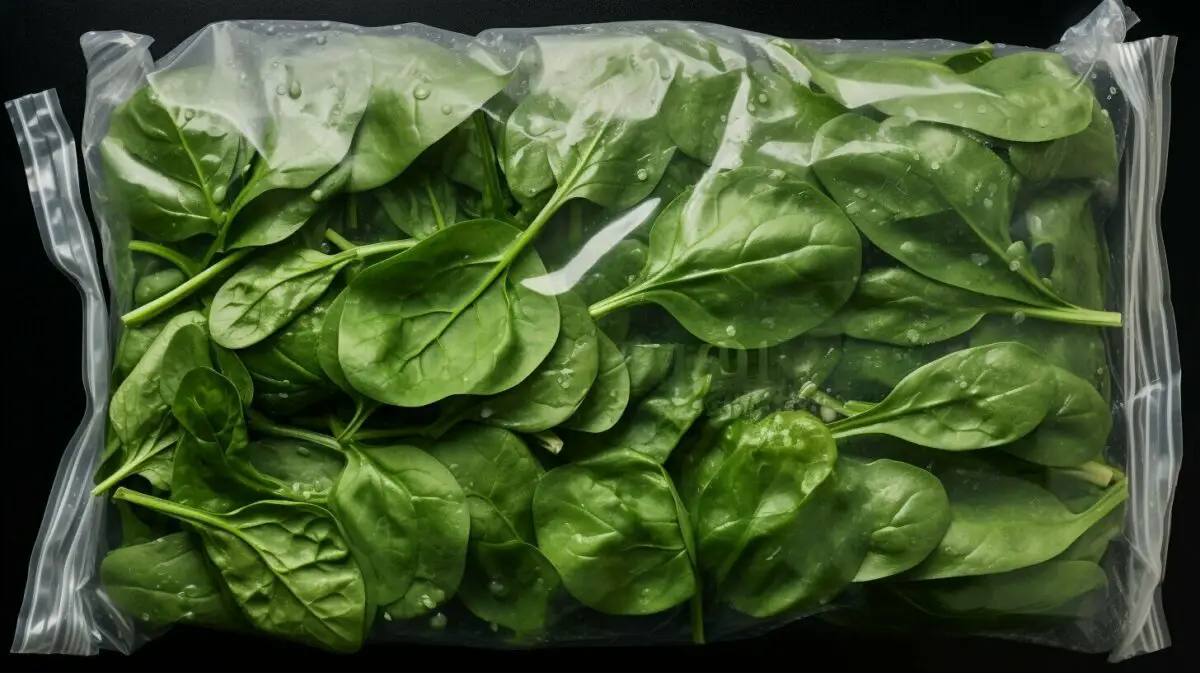
When freezing vegetables like spinach, it’s important to consider measurement conversions and find the best methods for optimal storage. Here are a few tips and tricks to help you freeze spinach successfully:
- Prepare the spinach: Start by washing the spinach thoroughly to remove any dirt or debris. Remove any wilted or discolored leaves. If you prefer to freeze whole spinach leaves, keep them intact. If you plan to puree the spinach, roughly chop it into smaller pieces before freezing.
- Choose the right containers: Freezer bags, plastic containers, or ice cube trays are ideal for freezing spinach. Ensure that your chosen containers are airtight to prevent freezer burn. Label the containers with the date for easy identification.
- Measurement conversions: If a recipe calls for a specific amount of fresh spinach, it’s helpful to know the equivalent measurement for frozen spinach. Generally, one pound of fresh spinach yields about 10 ounces of frozen spinach. Keep this conversion in mind when adapting recipes.
Remember, frozen spinach is best used in cooked or blended recipes. Thawed spinach tends to be wilted and watery, making it less suitable for raw applications. Try adding frozen spinach to smoothies, soups, stir-fries, dips, quiches, and pasta dishes for an extra boost of nutrients.
| Measurement | Equivalent |
|---|---|
| 1 cup fresh spinach leaves | 1/2 cup frozen spinach |
| 1 pound fresh spinach | 10 ounces frozen spinach |
By following these tips and tricks, you can confidently freeze spinach and enjoy its nutritional benefits all year long. Whether you choose to freeze whole leaves or puree, proper storage and measurement conversions will ensure that your frozen spinach remains fresh and easy to use in a variety of dishes.
Storing and Organizing Frozen Spinach
Properly storing and organizing your frozen spinach is key to maintaining its quality and maximizing its shelf life. Whether you freeze whole spinach leaves or puree it for convenient use, following these storage tips will ensure that your frozen spinach stays fresh and ready to use whenever you need it.
When it comes to storing frozen spinach, choosing the right containers is essential. Freezer bags and freezer containers are ideal for keeping your spinach fresh and preventing freezer burn. Make sure to label the containers with the date of freezing to keep track of its storage time. Remember, the longer spinach is frozen, the more likely it is to lose its flavor and texture. For best results, use frozen spinach within 6 months.
Organizing your frozen spinach can make it much easier to find and use when you need it. One option is to stack the freezer bags or containers neatly in your freezer, with the oldest ones in the front for easy access. Another option is to use a storage bin or basket specifically designated for frozen spinach. This can help keep your freezer organized and prevent any accidental spills or leaks.
| Storage Tips for Frozen Spinach |
|---|
| Use freezer bags or containers to prevent freezer burn. |
| Label containers with the date of freezing. |
| Use frozen spinach within 6 months for best quality. |
| Organize frozen spinach in a storage bin or basket. |
By following these simple storage and organization tips, you can ensure that your frozen spinach remains delicious and nutritious for months to come. So the next time you freeze spinach, remember to protect it with freezer bags or containers, label it properly, and keep it organized in your freezer. Your future self will thank you when you have a stash of frozen spinach ready to go for your favorite recipes!
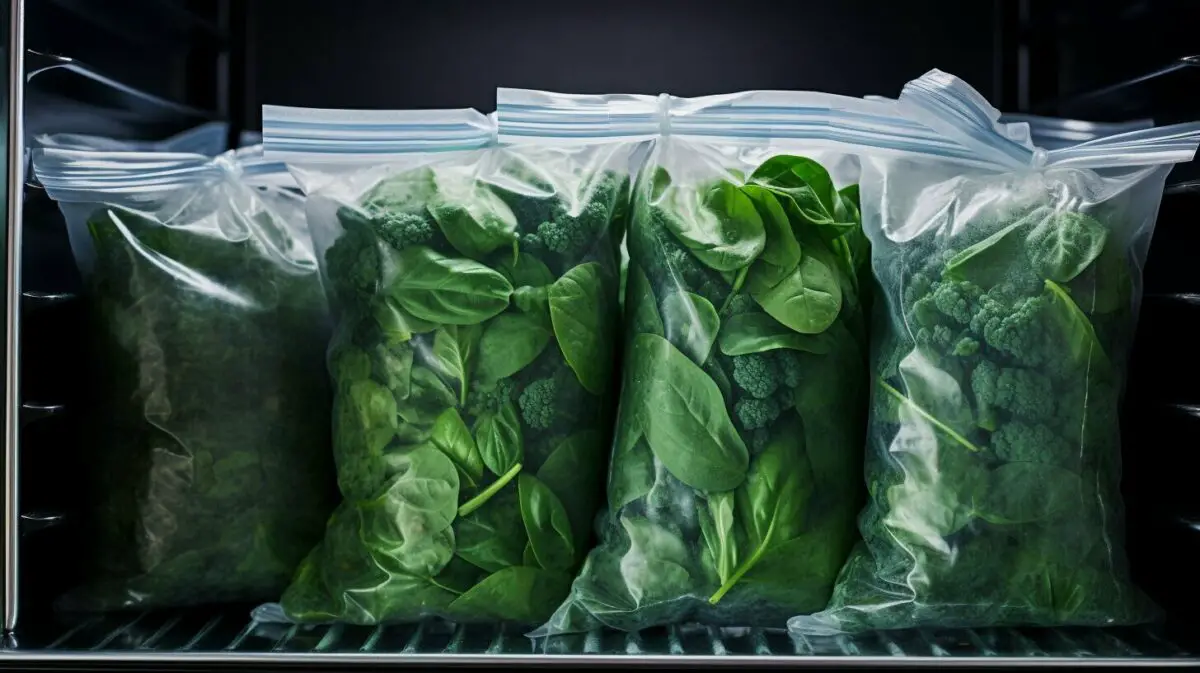
By following proper food safety guidelines, you can ensure that your frozen spinach remains safe and enjoyable to consume. Freezing spinach is a great way to extend its shelf life and have a readily available supply for your favorite recipes. However, it’s important to handle and store the spinach properly to prevent any contamination or spoilage.
When freezing spinach, always start with fresh, high-quality leaves. Remove any damaged or wilted leaves, and give them a good rinse under cold water to remove any dirt or debris. Pat them dry with a clean kitchen towel or paper towel to remove excess moisture.
How to Freeze Spinach – Best Practices:
| Step | Instructions |
|---|---|
| Step 1 | Prepare the spinach by removing damaged leaves and rinsing them under cold water. |
| Step 2 | Pat the spinach dry with a towel to remove excess moisture. |
| Step 3 | If freezing whole leaves, place them in airtight freezer bags, squeezing out as much air as possible before sealing. If pureeing, use freezer-safe containers or ice cube trays. |
| Step 4 | Label the bags or containers with the date of freezing to ensure proper rotation. |
| Step 5 | Store the frozen spinach in the freezer, ideally at temperatures below 0°F (-18°C). |
| Step 6 | Thaw frozen spinach in the refrigerator overnight before using. |
When it comes to storing frozen spinach, there are a few important factors to consider. First, make sure to use airtight freezer bags or containers to prevent any freezer burn or moisture absorption. Label the bags or containers with the date of freezing for easy rotation and to keep track of freshness.
When you’re ready to use your frozen spinach, be sure to thaw it properly. The best way to thaw frozen spinach is by transferring it to the refrigerator and allowing it to thaw overnight. Thawed frozen spinach will be wilted and watery, so it’s best to use it in cooked or blended recipes where the texture change won’t be noticeable.
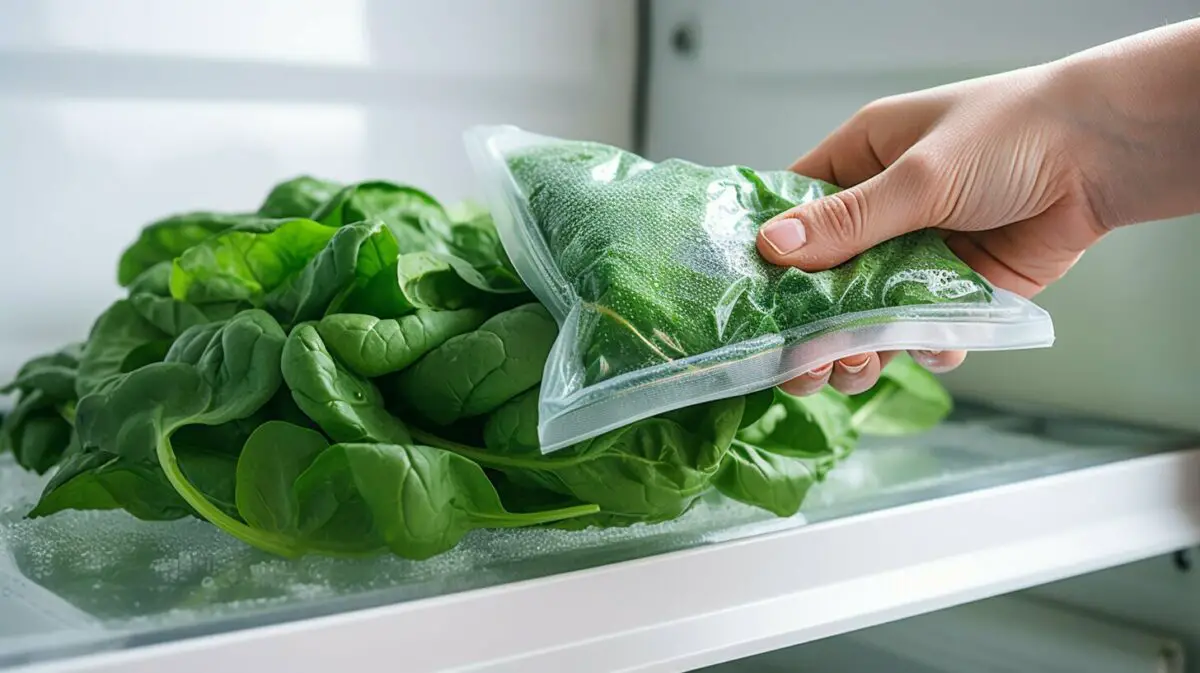
- Always start with fresh spinach leaves and remove any damaged or wilted ones.
- Rinse the spinach under cold water and pat it dry with a towel to remove excess moisture.
- Consider whether you want to freeze whole leaves or puree the spinach for easier use in recipes.
- Use airtight freezer bags or containers to prevent freezer burn and maintain freshness.
- Thaw frozen spinach in the refrigerator overnight before using it in your favorite dishes.
By following these simple guidelines, you can enjoy the convenience and nutritional benefits of frozen spinach while ensuring its safety and quality. Freeze spinach with confidence and have a steady supply of this versatile green vegetable for your culinary creations!
How to Freeze Spinach – Conclusion
Freezing spinach is a simple and effective way to preserve this nutrient-packed vegetable and ensure it’s always available for your favorite recipes. Whether you choose to freeze whole spinach leaves or puree them, the process is straightforward and requires minimal effort. By freezing spinach, you not only reduce produce waste but also save time and money by having this versatile ingredient on hand.
To freeze whole spinach leaves, start by selecting fresh and vibrant leaves, discarding any that are wilted or discolored. Place the spinach in a Ziploc freezer bag, removing as much air as possible before sealing it. Label the bag with the date, and pop it in the freezer. When it’s time to use the frozen spinach, simply thaw it in the refrigerator overnight or defrost it in the microwave for a quick solution.
If you prefer a more convenient and versatile option, consider pureeing the spinach before freezing. This allows you to easily incorporate it into a variety of recipes without the need for thawing. Simply blend the spinach in a food processor or blender until smooth, portion it into freezer bags, ice cube trays, or baby food containers, and freeze. Each portion can be used directly from the freezer, adding a boost of vitamins and minerals to your dishes.
Thawed frozen spinach may appear wilted and watery, making it best suited for cooked or blended recipes. Add it to smoothies, soups, stews, dips, quiches, pasta dishes, and more. The possibilities are endless, and frozen spinach provides a convenient way to enjoy this leafy green throughout the year. So, why not give freezing spinach a try? It’s a practical solution that ensures your spinach stays fresh and ready to elevate your culinary creations at any time.
How to Freeze Spinach – FAQ
Q: How do I freeze spinach?
A: Freezing spinach is easy. Simply remove any icky leaves, place the fresh spinach in a Ziploc freezer bag, squeeze out as much air as possible, and freeze. Another option is to puree the spinach and freeze it in freezer bags, ice cube trays, or baby food containers.
Q: Do I need to blanch spinach before freezing?
A: It’s not necessary to blanch the spinach if you plan to use it within six months.
Q: How long can I keep frozen spinach?
A: Frozen spinach can be kept for up to six months in the freezer.
Q: How should I thaw frozen spinach?
A: Thawed frozen spinach will be wilted and watery, so it’s best to use it in cooked or blended recipes. To thaw, simply leave it in the fridge overnight or defrost it in the microwave.
Q: What can I use frozen spinach for?
A: Frozen spinach works well in smoothies, soups, stir-fries, dips, quiches, and pasta dishes.
Q: Can I use frozen spinach in raw salads?
A: Thawed frozen spinach is best used in cooked or blended recipes, as it will be wilted and watery.
Q: Can I freeze spinach multiple times?
A: It is not recommended to refreeze spinach once it has thawed.
Q: Can I freeze spinach that has been cooked?
A: Yes, you can freeze cooked spinach for later use.
Q: How much frozen spinach should I use in recipes?
A: The amount of frozen spinach needed will depend on the recipe. It is usually best to follow the recipe’s instructions or adjust to taste.
Q: Can frozen spinach be used as a substitute for fresh spinach?
A: Yes, frozen spinach can be used as a substitute for fresh spinach in many recipes.
Q: Can I freeze spinach stems?
A: Yes, you can freeze spinach stems along with the leaves.
Q: Can I freeze spinach in glass containers?
A: Yes, you can use glass containers for freezing spinach. Just make sure they are freezer-safe and leave enough headspace for expansion.
Our Friends:
- https://unsophisticook.com/how-to-freeze-spinach/
- https://www.yummytoddlerfood.com/how-to-freeze-spinach/
- https://www.hgtv.com/outdoors/gardens/garden-to-table/how-to-freeze-spinach
Related Recipes:
 How to Make Pumpkin Puree? (Perfect Every Time!)
How to Make Pumpkin Puree? (Perfect Every Time!)
 How to Freeze Bananas? (Perfect Step-By-Step Guide)
How to Freeze Bananas? (Perfect Step-By-Step Guide)
 How to Freeze Avocados? (Perfect Step-By-Step Guide)
How to Freeze Avocados? (Perfect Step-By-Step Guide)
 How to Freeze Passion Fruit? (Step-By-Step Guide)
How to Freeze Passion Fruit? (Step-By-Step Guide)
 How to Freeze Oranges: Keep Citrus Fresh for Longer
How to Freeze Oranges: Keep Citrus Fresh for Longer
 How To Freeze Rhubarb (Perfect For Long Term Storage)
How To Freeze Rhubarb (Perfect For Long Term Storage)
 How to Freeze Broccoli? (Essential Step-By-Step Guide)
How to Freeze Broccoli? (Essential Step-By-Step Guide)
 How to Store Parsley? (Perfect Every Time!)
How to Store Parsley? (Perfect Every Time!)







